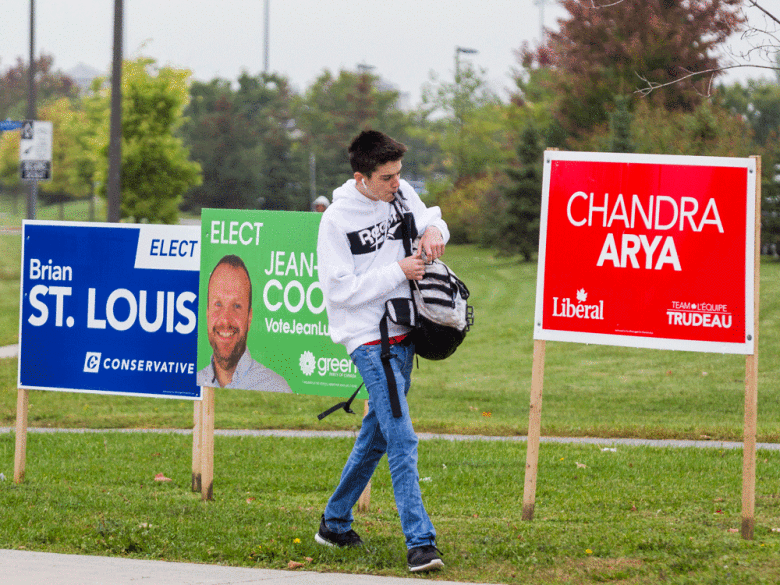Halfway through, the takeaway from this campaign, if the polls are any guide, is: nothing. Nothing has changed. Nothing is working. No one’s support has moved, much, up or down. For all the media hyperventilating about this or that poll — Tories up a point! Libs rebound by two! The Bloc is on the march!— it’s all within the margin of error.
No longer obliged even to pretend concern for the deficit, the parties have thrown everything they don’t have at the voters, a multibillion-dollar barrage of spending and tax promises, all of it borrowed, unlike anything we have seen in decades. Nothing. The prime minister was caught jumping about in blackface, the Conservative leader was found to have padded his resume, all manner of local candidates have been exposed as all manner of things. Nothing.
There may yet be some big shift, with the leading contenders still to face each other in the televised debates. The voters have still to be put on the strategic voting rack, with which they are so often menaced — Stop the Tories! Deny the Grits a majority! Don’t give the balance of power to the Bloc! — into abandoning their previous positions.
But with so little riding on the outcome — the Liberals and Conservatives, in particular, being content to make themselves all but indistinguishable from each other — and so little enthusiasm for any of the alternatives, it is possible to imagine the present trend, or lack of one, continuing through to election day.
If there is anywhere this could break, it will be in Ontario. The country is divided into rough thirds. West of Ontario, the Conservatives dominate, with a probable 75 or even 80 out of 107 seats, according to the latest projections. East of Ontario, the Liberals are very nearly as dominant, the probable winners of at least 70 of 110 seats. Neither is likely to change. The Conservatives have owned the West since 1958; the Liberals have owned Atlantic Canada since the 1980s; Quebec, since the collapse of the Bloc, has shown no clear trend.
It is Ontario where federal elections are won and lost (since 1921 only twice has a party won a majority of the country without winning a majority in the province), not only because it is so large, but because, of late, it has been so volatile. Ontario voted Liberal in 1974, Conservative in 1979, Liberal in 1980, Conservative in 1984. It kept the Liberals in power through the 1990s and 2000s, flipped to the Harper Conservatives in 2011, flipped back to the Trudeau Liberals in 2015. And it is in play, like no other region, in this election.
There may yet be some big shift
Of the 80 seats the Liberals won in Ontario last time, 25 were in what might be called solid blue territory — ridings that had voted Conservative the previous two, three or even four elections. In nine of those the margin of victory was less than five percentage points; the average margin over all 25 was less than 10.
In 27 of the 62 Ontario ridings where the Liberals and Tories finished one-two, the margin was 14 points or less. A seven-point swing in these ridings (hardly extraordinary: the same ridings saw a 14-point swing to the Liberals in 2011) would leave the Tories with nearly half the province’s seats — enough, combined with expected gains elsewhere, to give them roughly 160 nationwide: just shy of a majority. Pick up a few extra seats here and there in Atlantic Canada and Quebec, and you never know.
This is new. Once, it was not possible to win a majority by carrying just West and Ontario, as Joe Clark found in 1979. But by 2011 it was, as Stephen Harper proved: the centre of gravity of the country’s population had shifted west.
The point is not that the Tories can do it. The point is that without Ontario they cannot. Nowhere else offers the same potential gains. They are not about to set Quebec afire; they can expect only a modest revival in Atlantic Canada; they can scarcely do better than they already are in the West.
It is unclear what the Tories can do to turn things around
As late as June the province seemed within reach: the polls had the Conservatives two or three points ahead of the Liberals, reversing a 10-point deficit in the past election. But since then the Tories have fallen back, as memories faded of the SNC-Lavalin affair, to be replaced by vivid public disapproval of Doug Ford, the province’s bombastic, error-prone Conservative premier.
It is unclear what, if anything, the Tories can do to turn things around. The federal party’s campaign, with its heavy focus on “affordability” — and in particular its disdain for carbon pricing — seems based on the same themes as Ford’s, and steeped in the same assumptions: that Ontario, especially commuting, mortgage-heavy suburban Ontario, is not, at its core, the kind of progressive place the Liberals believe it to be; that it has more in common with its neighbours to the West than East; that it cares less about climate change than paying the bills.
It’s not an unreasonable thesis. But so far it does not prove to be bearing out, or not to the extent necessary for the Tories to win. They have closed that 10-point gap in the popular vote by a few points, but less because their own numbers have improved — they are currently roughly level with where they were in 2015 — than because a chunk of Liberal support has decamped for the Greens. They may yet break through, but time is getting short. With less than three weeks to go, the question hanging in the air is: do the Tories have a plan B in Ontario?














































